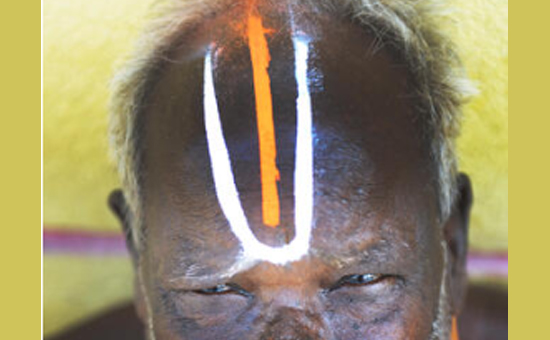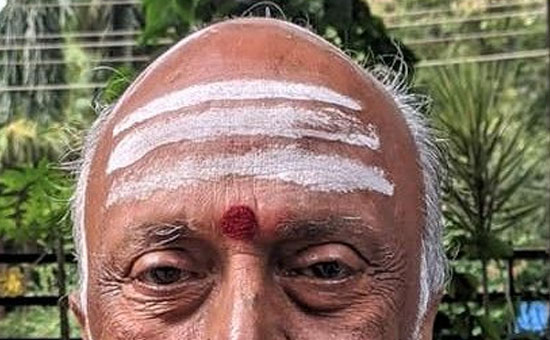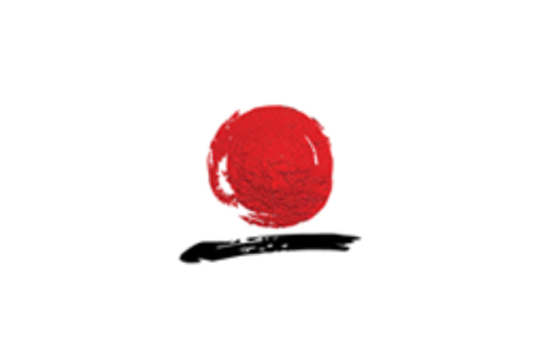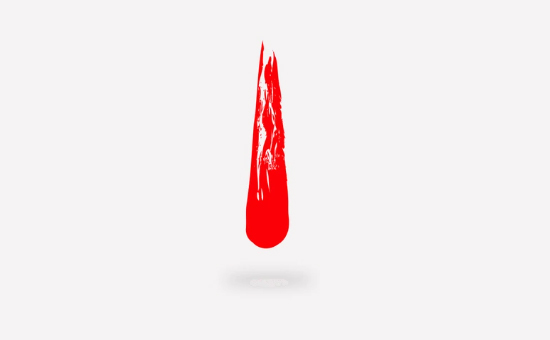- What
is Bhasma, its Spiritual significance, importance and how to apply? What do 3
horizontal and vertical lines on forehead symbolize? Cautionary steps before
buying Bhasma.
Ever
wondered why the Hindus wear some sacred mark on their forehead?
There is a saying: "Lalaata Shoonyam Shmashaana Tulyam, “which translates to "a forehead bereft of a sacred mark is comparable to a cemetery,” hence every Hindu has a habit of applying either Vibhooti (Bhasma -
Sacred Ash), Chandana, Gopichandana or Kumkuma on one’s forehead. It may be some form of Tilaka, Urdhvapundra (three
vertical lines), or Tripundra (three horizontal lines of vibhuti) according to one’s own family tradition, belief or initiation. Hindus ensure that these marks remain on their bodies throughout the day.
The
Urdhvapundra which the Vaishnava devotees adorn signifies carrying the footprint of Lord Naaraayana on the body and forehead. It is called as ‘Naama’ as every mark is worn uttering a particular name (Naama) of Lord Vishnu. It is done so using some form of earth, be it Gopichandan which is the
sediment of Gopitalab or white earth, also known as Thiruman in
Tamizh.
 Naama.
Naama.
Tripundra, made by smearing
vibhuti also known as Bhasma in three parallel lines across the forehead and
other parts of the body like the chest, stomach, arms, elbows, and wrists, is
especially significant for devotees of Lord Shiva. It is believed that those
who wear vibhuti purify themselves from sins and also absolve the sins of
others who see them adorned with it.
 Tripundra.
Tripundra.
Spiritual
Significance of Bhasma
It
is called as the tripundra since there are three lines horizontal and parallel
to each other. The three lines signify the three qualities which constitutes
the human being, namely Sattva (characterised by piety, clarity, freedom
from agitation etc.), Rajas (characterised by activity, anger etc.) and Tamas
(characterised by dullness, heaviness etc.). To signify that the three gunaas
ought to be kept in right balance, three lines are drawn on forehead.
The
Bhasma denotes that at the end of life, everything in the world is reduced to
nothingness. The pure white ash stands for Suddha Sattva i.e. Ishvara alone remains. The bhasma should be applied with the attitude - “May I remember the Lord. May this pious feeling pervade all my activities.” The sacred mark keeps reminding us of this attitude to be followed in our lives.
The term "Bhasma" is etymologically explained in some works from the two components “bha” (bhartsana - meaning “to destroy”) and “sma” (smarana- to remember”). Thus, Bhasma signifies “that by which our sins are destroyed and the contemplation on the Lord is made steady.”
Another name for Bhasma is Vibhuti, which translates to ‘aishvarya’ or glory. All the comforts and pleasures one might attain in the world are not viewed as spiritually significant, but the highest treasure that one can have as a result of enormous merits performed over the chain of births, is the opportunity to be born in the fold of Sanatana Dharma and further, be blessed with Bhasma smeared on his forehead. Hence, it is called as Vibhuti.
Preparation
of Bhasma
It
is important to note that not all ash is considered Bhasma; only the ash
resulting from these specific sacred ritual offerings hold this sacred status.
The
Homa ritual is a profound spiritual practice where offerings are made
into a fire accompanied by sacred mantras. This act symbolizes the surrender of
ego and egocentric desires into the purifying fire of knowledge. The resultant
ash, Bhasma, represents the purified mind. The fire of knowledge in the
Homa burns away the ignorance and inertia. By the time Bhasma is
formed, all original matter is entirely transformed, leaving no trace of its
previous state.
One
can perform the homa as per the Agamic procedure or using Vedic mantras, for
attaining the Bhasma. Cow-Dung balls are covered in rice-husk and allowed to
slow-burn for seven days. When gently removed the burnt husk reveals the white
residue from Cow-dung balls. This is then sieved through fine cloth and stored
in dedicated containers for the use. This Bhasma is then offered in Abhisheka
rite and received as Prasad.
The
Process and Benefits of Applying Bhasma
The
application of Bhasma on the body serves as a reminder to transcend false
identification with the physical self and to recognize the deeper spiritual
essence within.
Traditionally,
Bhasma is taken using the thumb and ring fingers and placed on the left palm.
It is then mixed with little water accompanied by specific mantras or Shiva
Panchakshari and then applied to sixteen specific points on the body, or at
least on the forehead. Scriptures also recommend Mrityunjaya mantra to be
chanted while applying bhasma on the forehead.
tryambakam
yajaamahe sugandhim pushtivardhanam
urvaarukamiva
bandhanaat mrtyor muksheeya maa amrtaat
Translated as, “We worship the three-eyed Lord Shiva who nourishes and spread fragrance in our lives. May He free us from the shackles of sorrow, change and death – effortlessly, like the fall of a rip cucumber from its stem.”
The
Bhasma should ideally start from the end point of the left eye-brow and end on
the right end of the eye-brow. Applying Bhasma at these points enhances their
sensitivity and receptivity, facilitating a higher spiritual experience.
Some
ascetics rub it all over the body, which is called as Uddhulana.
This sacred ash is intimately associated with Lord Shiva, who is often depicted
with Bhasma smeared all over His body.
Bhasma
is typically worn with a red tilaka using Kumkum. The vibhuti symbolizes Shiva,
while the red
tilaka represents Shakti,
signifying the union of Shiva and Shakti that forms the universe.
 Kumkum is part of the eSamskriti logo.
Kumkum is part of the eSamskriti logo.
 Tilak too is part of the eSamskriti logo.
Tilak too is part of the eSamskriti logo.
The
Sacred Significance of Bhasma (Holy Ash)
Bhasmadharana, the practice of
applying sacred ash, holds deep spiritual and ritualistic significance in Hindu
tradition. It is rooted in ancient scriptures, and this practice is not merely
symbolic but imbued with profound meanings and powerful effects which are found
described in various sacred texts.
Bhasmajabala
Upanishad
The
Bhasmajabala Upanishad, one among the 108 Upanishads, is divided into two
parts.
The
first part, consisting of 17 verses explained by Bhusunda Jabala, details the
precise procedure for creating and applying Bhasma. The second part, comprising
52 verses, features a conversation between Bhusunda Jabala and Lord Shiva. In
this dialogue, Lord
Shiva provides comprehensive answers about worship, the creation,
sanctification, and proper application of Bhasma, and the associated rituals.
Connecting these scriptural instructions with practical experiences, the venerated saint Thirugnana Sambandar demonstrated the miraculous powers of vibhuti and celebrated its greatness in “Thiruneetru Pathigam”:
Mandhira
maavadhu neeru
| Vaanavar meeladhu neeru |
Sundaramaavadhu
neeru | Thudhikkap paduvadhu neeru |
Thandhira
maavadhu neeru | Chamayaththil ullaadhu neeru |
Senthuvar
vaayumai pangan | Thiruaalavaayaan Thiruneerae |
Translated
as, Mantra is the Bhasma; Higher than heavenly beings is the Bhasma; Beauty is
the Bhasma; Praised is the Bhasma; Technique is the Bhasma; In religion is the
Bhasma; The Lord of Thiruaalavaay (Lord Sundareshwarar, Madurai), who shares
his form with the Parvati, His Holy Bhasma.
Further emphasizing the healing properties of Bhasma, Sri Adi Shankaracharya extolled the miraculous powers of Lord Kartikeya's vibhuti in his “Sri Subramanya
Bhujanga Stotra,” sings thus in the sacred Kshetra of Thirucchendur:
apasmaara kushta kshayaarsha
prameha|
jvaronmaada
gulmaadi rogaamahanta||
pishaachaashcha
sarve bhavatpatra bhoothim|
vilokya
kshanaat taarakaare dravante||
Translated
as, Oh Conqueror of Tarakasura! Severe epilepsy, leprosy, consumption, lung
diseases, venereal diseases, fevers, and mental diseases of all types flee at
the sight of Thy Vibhuti contained in a leaf. (In Thirucchendur, the Holy
vibhuti is given as a prasada by placing it on the left of Guettarda speciosa , called as ‘panner ilai’ in Tamil.)
Wearing
the sacred signs on our forehead should therefore be the pride of every
follower of Sanatana Dharma.
A
word of Caution
Many
Vibhuti manufacturers today adulterate their products with ashes from Friesian
animal dung, rice bran, rice husks, boiler waste, thermal power plants, white
stone powder, paper cellulose, calcium carbonate, and chemicals. These
substances render the vibhuti unfit for spiritual use. This adulteration may
also lead to skin allergies. It is essential for the devotees to ensure that
the vibhuti they use is free from these contaminants and is traditionally
prepared.
To
read all articles by author
Author Dr Ketu Ramachandrasekhar is co-founder of Bharat ke Wow and course developer at Siddhanta Knowledge Foundation. He is also an expert panel member in Sangeet Natak Akademi. He has his Doctorate in Indian Epistemology and was selected as a Fellow from hundred young scholars across India for Studies in Neuro Aesthetics and Indian Rhetoric by Ministry of Culture, GOI. He was a part of Academic Team of scholars across Europe on discussion of Natya Texts. His expertise in Tantrashastra and Shaiva Pratyabhijna School is well recognised. He has several research articles and books to his credit which includes a detailed study of Abhinayadarpana of Nandikeshvara, Devi Mahatmya and others.
Editor
Notes –
The
eSamskriti logo has a Kumkum in the centre. To read five meanings of the significance
of the logo
Here
is significance one being excerpts from In
Indian Culture Why do we by Swamini Vimalananda and Radhika
Krishnakumar.
“In many communities married women are expected to sport a kumkum mark on their forehead at all times. In many parts of North India the tilak is a respectful form of welcome, to honour guests or whilst bidding farewell to a son about to embark on a journey or going to war. The tilak covers the spot between the eyebrows, which is the seat of memory and think also known as Aajna Chakra in
Yoga. The tilak invokes a feeling of sanctity in the wearer and is a blessing
of the Lord and a protector against wrong tendencies and forces.
The entire body emanates energy in the form of electromagnetic waves - the forehead and the subtle spot between the eyebrows more so. That is why worry generates heat and causes a headache. The tilak cools the forehead, protects us and prevents energy loss.”